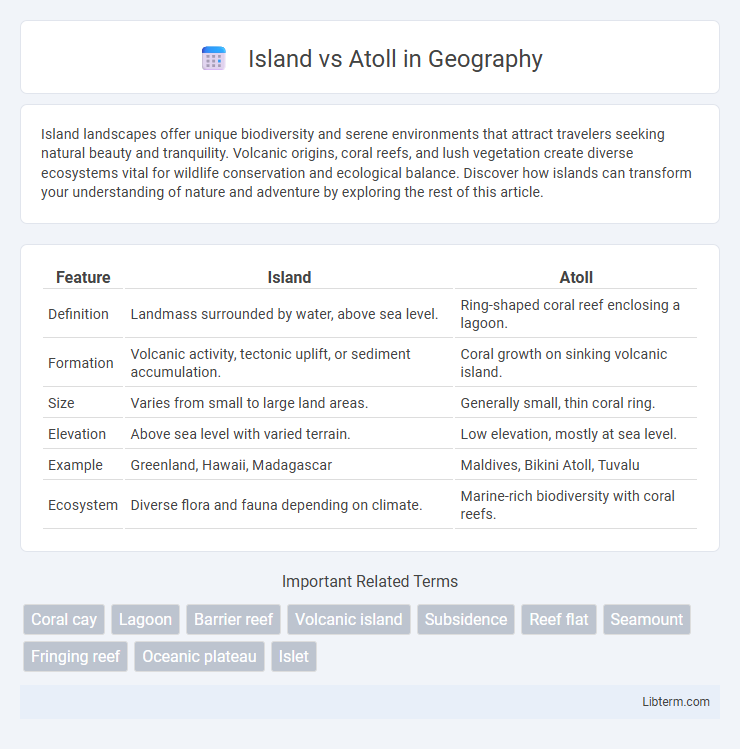Island landscapes offer unique biodiversity and serene environments that attract travelers seeking natural beauty and tranquility. Volcanic origins, coral reefs, and lush vegetation create diverse ecosystems vital for wildlife conservation and ecological balance. Discover how islands can transform your understanding of nature and adventure by exploring the rest of this article.
Table of Comparison
| Feature | Island | Atoll |
|---|---|---|
| Definition | Landmass surrounded by water, above sea level. | Ring-shaped coral reef enclosing a lagoon. |
| Formation | Volcanic activity, tectonic uplift, or sediment accumulation. | Coral growth on sinking volcanic island. |
| Size | Varies from small to large land areas. | Generally small, thin coral ring. |
| Elevation | Above sea level with varied terrain. | Low elevation, mostly at sea level. |
| Example | Greenland, Hawaii, Madagascar | Maldives, Bikini Atoll, Tuvalu |
| Ecosystem | Diverse flora and fauna depending on climate. | Marine-rich biodiversity with coral reefs. |
Introduction: Understanding Islands and Atolls
Islands are landforms surrounded by water and can vary greatly in size, origin, and ecosystem, often formed through volcanic activity or sediment deposition. Atolls are ring-shaped coral reefs or islands encircling a lagoon, primarily formed from coral growth on the rim of submerged volcanoes. Understanding the distinct geological processes and ecological characteristics of islands and atolls highlights their unique roles in marine biodiversity and coastal environments.
Defining Islands: Types and Characteristics
Islands are landforms completely surrounded by water, varying widely in size and origin, including continental, volcanic, and coral types. Continental islands emerge from the continental shelf, volcanic islands form from underwater volcanic activity, and coral islands are created from coral detritus and associated organic material. These islands differ in topography, biodiversity, and ecological systems, reflecting their unique geological processes and environmental conditions.
What is an Atoll? Formation and Features
An atoll is a ring-shaped coral reef, island, or series of islets surrounding a lagoon, formed from the subsidence of a volcanic island. Coral polyps build the reef on a sinking volcanic foundation, creating a lagoon as the volcanic island erodes beneath the sea surface. Atolls feature shallow lagoons, rich marine biodiversity, and are primarily found in tropical ocean regions, distinguishing them from typical islands formed by tectonic or volcanic activity.
Geological Origins: Island vs Atoll
Islands form primarily through volcanic activity, where magma from beneath the Earth's crust rises and cools to create landmasses above sea level. Atolls develop from coral reefs growing around volcanic islands that gradually subside or erode, leaving behind a ring-shaped coral reef with a central lagoon. The geological origin of islands involves tectonic or volcanic processes, while atolls result from biological coral growth combined with geological subsidence.
Biodiversity and Ecosystems
Islands support diverse ecosystems with distinct flora and fauna, often including endemic species due to isolation and varied habitats such as forests, wetlands, and freshwater sources. Atolls, primarily composed of coral reefs surrounding a lagoon, harbor rich marine biodiversity but have limited terrestrial ecosystems, typically hosting specialized plants and seabirds adapted to saline and nutrient-poor conditions. The contrast in ecosystem complexity influences conservation strategies, with islands requiring habitat protection for unique land species while atolls need coral reef preservation to maintain marine biodiversity.
Human Habitation and Culture
Islands often support diverse human habitation due to their larger land area, fresh water sources, and fertile soil, enabling established communities with rich cultural traditions and infrastructure. Atolls, typically composed of coral reefs encircling a lagoon, offer limited freshwater and arable land, often resulting in smaller, isolated populations with unique maritime cultures adapted to resource scarcity and fishing livelihoods. The cultural practices on islands reflect varied influences from trade, migration, and historical development, while atoll communities emphasize sustainable interactions with fragile ecosystems and ocean-based economies.
Economic Significance: Tourism and Livelihoods
Islands serve as major hubs for tourism, providing diverse ecosystems and cultural experiences that boost local economies through hospitality, recreation, and transportation services. Atolls, characterized by coral reefs and lagoons, attract niche tourism markets such as snorkeling and diving, supporting small-scale fisheries that sustain local livelihoods. The economic significance of both is tied to natural resource management and sustainable tourism development, which ensures long-term community resilience and income generation.
Environmental Challenges and Conservation
Islands face environmental challenges such as deforestation, habitat loss, and freshwater scarcity, while atolls struggle with rising sea levels, coral bleaching, and limited land area. Conservation efforts for islands often focus on preserving biodiversity hotspots and managing invasive species, whereas atoll conservation prioritizes coral reef protection and sustainable water management. Both ecosystems require adaptive strategies to mitigate climate change impacts and support resilience in fragile marine environments.
Notable Examples: Famous Islands and Atolls
Famous islands include Greenland, Madagascar, and Hawaii, each known for unique biodiversity and cultural heritage. Notable atolls such as Bikini Atoll in the Marshall Islands and Maldives' coral atolls are renowned for their circular coral reefs and lagoons formed from volcanic island subsidence. These geographic formations highlight distinct ecological and geological characteristics essential for marine ecosystems and coastal communities.
Conclusion: Key Differences and Similarities
Islands are landmasses surrounded by water, formed by tectonic activity or volcanic processes, while atolls are ring-shaped coral reefs encircling a lagoon, primarily formed from coral growth on submerged volcanic islands. Both islands and atolls support diverse ecosystems and are surrounded by marine environments, but atolls are typically low-lying and more vulnerable to sea-level rise. Understanding these differences and similarities aids in geographic classification, environmental studies, and marine conservation efforts.
Island Infographic

 libterm.com
libterm.com